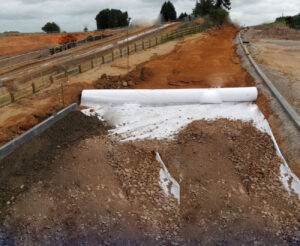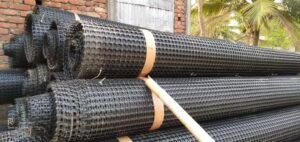The Ultimate Guide To Geotextile Fabric
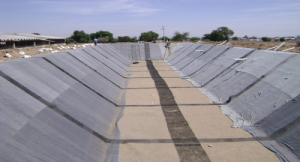
Geotextile | Definition
Geotextile introduce permeable synthetic textile materials. Broadly, it is produced from polyester or polypropylene polymers. Geotextile are accustomed to increasing soil stability, providing erosion control, or aiding in drainage.
A form of geotextile can be produced using different polymers and manufacturing processes that make them beneficial in a variety of civil construction applications. Geotextile and geosynthetics products including geogrids, geonets, and others are as well as suitable for geotechnical and environmental engineering design.
Geotextile | Types
Geotextile are divided into principally two types: Fiber-based Geotextile & Fabric-based Geotextile. Fiber-based Geotextile are specified below:
Natural Fibers
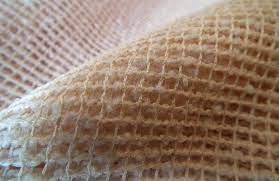
Natural fibers are composed of plant, animal, and mineral origins. A huge quantity of these fibers is available worldwide. The natural fibers have some properties to help manufacture geotextile. They are of high strength, high modulus, less breaking extension, and poor elasticity. Yarn and fabrics originating from natural fibers show a poor level of creep ability during application. Mineral fibers are tense and low flexible that’s why mineral fibers do not apply to manufacturing geotextile as an industrial application. The important natural fibers which are used in manufacturing geotextile that are jute, sisal, flax, hemp, abaca, ramie, and coir.
Synthetic Fibers
The synthetic or man-made fibers used for geotextile are termed geosynthetics. Hence, there is a difference between geotextile and geosynthetics that’s geotextile are manufactured from both fibers such as natural fibers and synthetic fibers but geosynthetics are made from just synthetic fibers. Thus, having said that all geotextile are not geosynthetics but all geosynthetics are geotextile. The four polymeric families are identified as raw materials for geosynthetics namely polypropylene, polyester, polyamide, and polyethylene.
Polypropylene
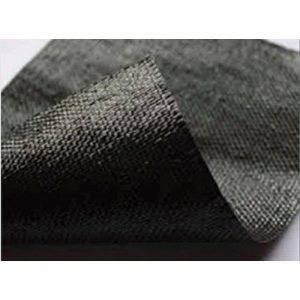
Polypropylene (PP) is the most applied polymer for the manufacturing of geotextile because of its low cost, appropriate tensile properties, and chemical passivity. Polypropylene has a poor density thence it has a low cost per unit of volume. The disadvantages of polypropylene are it is very much reactive to UV rays and at higher temperatures. It has low creep and mineral resistance. Polypropylene should be used under proper installation and meteorological conditions.
Polyester
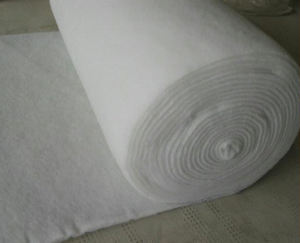
Polyester (PSF) is used as geotextile due to its superior creep resistance and persistence values. It is suitable when geotextile are required for high stresses and bluff temperatures. The disadvantage of polyester is hydraulic deterioration in soils over the pH10. Polyester fabric is very economical, and it is established in PET chips or plastics.
Polyamide
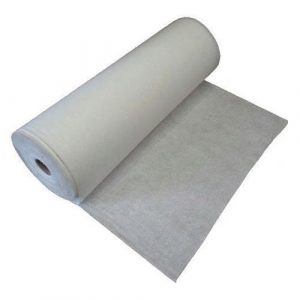
To manufacture traditional geotextile polyamide (PA) is essential .Nylon 6 and Nylon 6:6 are applied to make it. The choice of polymers is based on strength, creep behavior, fabric structure & finishing specifications. Synthetic polyamide is utilized for it but not natural polyamide such as silk, protein is not acceptable for it.
Polyethylene
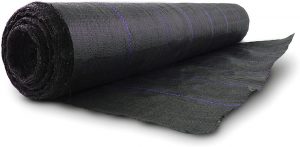
Polyethylene (PE) is used in the case of just woven coated geotextile. The advantages of its uses are minimal thermal expansion and contraction, and extra-sharp resistance providing tear and punctures. It is UV rays resistant and it has a huge heat seaming resistance.
Differences between Woven and Non-woven Geotextile
Ensuring you make the right choice of geotextile fabric for your project signifies understanding the differences between them. Typically, woven geotextile have greater strength values, although non-woven geotextile have higher flow rates and absorptive. Here’s a summary of the differences.
PHYSICAL ATTRIBUTES: Woven fabrics are plastic-like in feel and characteristic, whereas non-woven fabrics have a fuzzy-like feel and characteristic.
MANUFACTURING PROCESS: Woven geotextile in Malaysia are fabricated together on a film or loom whereas non-woven geotextile are manufactured by joining fibers together.
REFER: Woven’s are referred to by tensile strength while non-woven is referred to by weight, generally grams per square meter.
STRENGTH: Woven fabrics from Malaysia are fabricated by thread crossing which creates a sturdy reinforcement, meaning they are stronger and more enduring than non-woven because of woven fabrics.
ELONGATION: Non-woven geotextile will have much larger elongation (higher than 50%) than woven geotextile (between 5% and 25%).
WEIGHT: The weight of wovens is barely ever specified because they are usually used to provide reinforcement and separation despite the weight. On the other side, the weight of non-woven is much specified.
COST: Non-woven fabrics tend to be more budget-friendly because they are quicker to produce, as woven fabrics are more costly to produce and take more time and effort to manufacture.
6 Popular Applications Of Geotextiles
Geotextile are basic tools in the construction of roads, drains, harbor works, breakwaters, and many other undertakings. They’re as well as often used in civil engineering. What makes them dynamic is their ability to perform different functions within all of these different projects. Here’s a look at some of the most common and popular applications for geotextile.
Separation
This application is just what the name implies. The geotextile is laid between two distant layers of different materials. This could be two distinct types of soil, old and new pavement, or soil and advanced construction. There are a perpetual amount of possibilities. Separation is almost indistinguishable from stabilization, but there are some distinct variations to attain stabilization.
Stabilization
In a standard stabilization application, the geotextile is laid on a flexible material. Most frequently, that’s damp, soft soil. The geotextile is then able to let water from the soft soil pass into a much more freely draining material. This cements the bottom layer, which strengthens it and creates a more reliable base.
Reinforcement
In this application, the geotextile is an origin of strength instead of strengthening the bottom soil as in stabilization. That as well as means that rather than being putted on top of a layer that requires to be strengthened, reinforcement applications are accomplished by putting the layer within the weak layer and In this manner, reinforcement through geotextile is likely to reinforcement techniques for other materials such as concrete.
Filtration
This application is as well as similar to stabilization in that the main function is to allow water to be passed out of the covered layer. The objective of filtration is to remove water without letting soil or other fine materials pass through. This is adept in conjunction with a filter behind the geotextile. Water is altogether removed rather than filtered into another material.
Moisture Barrier
This application for geotextile is the antithesis of what’s been discussed. Rather than letting water through the geotextile, water and other materials are obscured by applying an asphaltic emulsion. This makes the geotextile damp-proof and ideal for use in activities like pavement rehabilitation.
Whatever your requirements for geotextile are, Ocean Non-Woven Pvt. Ltd has the products you need to do the job right. Contact us, stop by and say hello, or browse through our online products on our website.
Ocean Global has a list of solutions directly available for potable water storage infrastructure, including systems for dams and reservoirs that help prevent leaks. We also provide Oasis floating covers for potable water reservoirs which help in the preservation of our water supply systems by protecting the surface thereby maintaining the quality of the water and preventing water loss through evaporation.
How Thick Is Geotextile
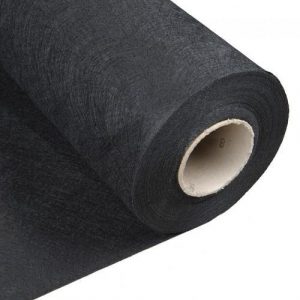
Geotextile is a penetrating synthetic material used to improve soil characteristics. It can separate, filter, harden, protect and drain water when used in conjunction with soil. Geotextiles are suitable for many infrastructure projects such as roads, harbors, dumping sites, dumping structures, and other community projects.
GEOTEXTILE TYPES
Geotextiles are made of polymers such as polyester or polypropylene. They are divided into 3 categories according to how they are arranged:
1. Woven Geotextile
2. Non-Woven Geotextile
3. Knitted Geotextile
WOVEN GEOTEXTILE
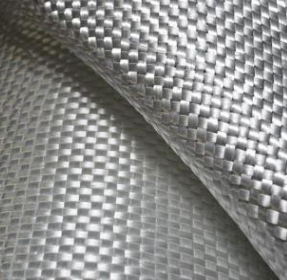
The geotextile commonly found is of woven type and is produced by adoption techniques such as weaving standard textile fabrics. This type has the appearance of a feature of two sets of matching threads or strings. A long-running thread is called a warp and another perpendicular is called a weft.
NON-WOVEN GEOTEXTILE

Non-woven geotextile is produced from continuous filament fiber or short-staple fiber. Threading is done using thermal, chemical, or mechanical techniques or combinations of techniques.
Geo-fibers obtained from mechanical or chemical compounds or thermal composites have a thickness of 0.5-1 mm while non-chemical bonds are relatively thick in comparison with a thickness of 3 mm.
KNITTED GEOTEXTILE
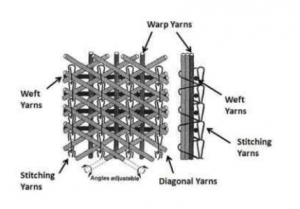
Knitted geotextiles are produced by the process of tying a series of threads together. All knitted geosynthetics are created using knitting techniques in line with other geosynthetics practices, such as weaving.
Apart from these three geotextiles, other geosynthetics used are Geonets, Geogrids, Geo-cells, Geomembranes, Geocomposites, etc. each has its unique features and uses for special operations.
PUNCTURE RESISTANCE
Geotextile-related ability is to maintain objects or stones from exploding or pushing on objects. Nonwoven geotextiles have high piercing resistance which is necessary to prevent construction damage during the installation and placement of filling materials with sealing equipment. Woven geotextiles usually have very low puncture resistance and often (obscure) injuries occur during installation resulting in reduced performance or long-term failure. Strong puncture resistance involves pushing a 50mm wide plunger into the geotextile and measuring with KN (top is better). Strong puncture resistance involves dropping the cone into geotextile and measuring the hole size in mm (lower is better).
TENSILE STRENGTH
Woven fabrics from Malaysia are woven by crossing yarn which creates a strong bond, which means they are stronger and more durable than non-woven due to woven fabrics.
Non-woven geotextile will have a much greater elongation (over 50%) than woven geotextile (between 5% and 25%).
LIFE EXPECTANCY
Geotextile synthetic material is a polymer material or polymer engineering material used in geoengineering and civil engineering. It is used in many fields such as water conservation, dams, road construction, etc. The long service life of geotextile can provide more than 50 years, which can reduce costs.
In experiments, the service life of fiber geotextile is longer than that of polypropylene geotextile, which accelerates geotextile aging by more than 50 years.
Geotextile manufacturing materials are not related to service life, and their features are also related. Proper geotextile will withstand the aging of more than 50 years, so the manufacturer can use it.
However, the life of the geotextile fabric can be extended up to 20 years with various treatments and combinations.
PROPERTIES AND TEST METHODS
Geotextile structures are usually divided into the following groups: physical, mechanical, hydraulic, tolerant, and degradable. Each group includes experiments showing a different aspect of geotextile and their function. In addition to these structural groups, geotextile testing may be considered an indication of performance. The index test is used for the general presentation of a geotextile product and does not provide values that can be used directly for design purposes, while performance testing provides information about the expected behavior of geotextile in the engineering system.
Physical properties are used to express geotextile in an accepted, structured, and obtained state by reference index testing. Typical visual structures include specific gravity, unit size, thickness, and durability.
The mechanical properties provide an understanding of geotextile strength and/or pressure under various loads. Typical mechanical properties include compression, tensile strength, tear strength, puncture strength, and seam strength. A variety of tests are available to determine geotextile strength, usually designed to depict the conditions encountered in-field installation.
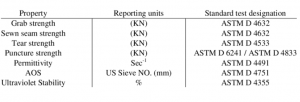
One of the most essential strength properties for a geotextile is tensile strength. Geotextile tensile strength is measured by tying the opposite ends of a geotextile sample to a machine test and stretching the template until a failure occurs. In general, both the energy applied to the geotextile and the types of geotextile are measured, allowing the observation of the stress-strain curve and the development of a compatible module. Several tests are available to measure the strength of the geotextile tensile, with the main variations depending on the type of clamp used and the geotextile template size. The grab tensile test, ASTM D 4632, is a strong geotextile strength that is often specified and reported. It involves testing a diameter of 100 mm wide by 150 mm long geotextile specimen.
Other geotextile strength tests focus on making sure the geotextile is strong enough to withstand the pressures of installation, often the heaviest pressures placed on the geotextile during its lifetime. The tests that are usually specified are tears and the power of piercing. The penetration strength of geotextile is usually measured by making small cuts in the adjusted pattern as well as testing on a solid test machine. The Puncture strength is tested by measuring the force required to strike a probe through a geotextile specimen. Generally, the ASTM D 4833 is a standard specification for obtaining puncture strength.


